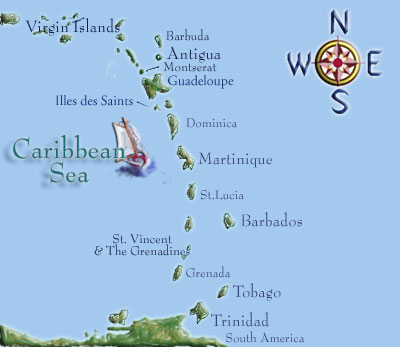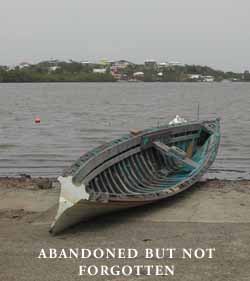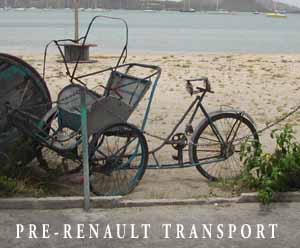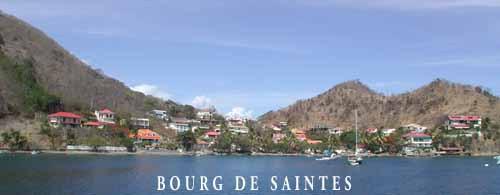
|

|
LINKS FOR THE YEAR 2003 |
| [JAN] [FEB] [MARCH] [APRIL] [MAY] [JUNE] [JULY] [AUG] [SEPT] [OCT] [NOV] [DEC] |
Archives [Intro] [2000] [2001] [2002] |
|
Log for the week of May 4, 2003 Marin, Martinique by APW Fifty-six days from Capetown to the Caribbean. Of course that includes two stops, but it still feels like we have landed on another planet, and with that comes sticker shock. Our first lunch on shore came to fifty dollars. Our friends on Red Oranda left Capetown three days before us, sailing directly for the Azores. They lost their auto-pilot and were hand steering for several days and through one tropical storm, one hour on and one hour off. But, they made it safely to San Miguel. Others were not so lucky. One yacht-"Stewball"was lost on a reef off Brazil- the couple on board are now heading to Trinidad on a friend's yacht. Worst of all has been the news of Isi. His boat Islero was found twenty miles from Abidjan off the Ivory Coast. No one was on board. The boat traveled 1500 miles from it's last reported position. We will never know what actually happened. The airwaves are full of banter. Everyone has his or her own theory. Phil and I probably spent more time with Isi than anyone else while in Capetown. Yes, at times he seemed depressed. But not anymore than the rest of us. We were all anxious to get home. The thought of the long crossing still to come had many of us drowning our sorrows with gin. He joked about his girlfriend leaving him in New Caledonia. I think it was bothering him, but he was getting over it. 'She thought I was too crazy'he said. "You have to be crazy to sail around the world" we replied, "Who in their right mind would leave their job, lawnmowers and television remotes for this life?" He had a huge celebration to get to in the Canary Islands on April 15. He had radio shows once a week and a log updated daily through Inmarsat-C. We made arrangements to meet in Andalucia in April 2004. He was going to show me "the Spanish horse", as I am going to get a Lippizan or an Andalusian once we complete a few other adventures. He gave me a beautiful book that a very good friend gave him, about the royal Andalusian stables. I painted a picture of his boat Islero sailing under Table Mountain and gave it to him. A gift he really seemed to appreciate. Perhaps the first portent of things to come, I painted no one in the cockpit, the boat seemingly under sail by itself. Before we heard on the Inmarsat-C that Islero was missing, I had a very strange dream. Isi appeared in it and I said we couldn't wait to see him in Spain. I was looking forward to eating his mother's paella. He said there would be no paella. I said, 'Oh? Did something happen to his mother?'. "No," he said shaking his head "that is not it". In the dream he had a look that we had occasionally seen with him. Like he was staring at a dead bug on a table. The very next day we were notified that he was overdue. Something was bothering him and I had attributed it to a money problem, so never asked. It is easier to think that Isi just had enough with the passage and jumped overboard. All of us think it once or twice for a second or two. That can give you an idea how bad the boredom is on passage and more importantly, how bad the continual motion is being on a boat. You just want it to stop. Just for five minutes. Since she is made of wood, Iwalani is probably one of the smoothest boats out here. We can walk, jog or exercise on our decks-even in 25 knots of wind, something you can't do on any other boat we've seen out here. If I were on my own fiberglass boat "Petrel", confined just to the cockpit or down below, slamming and banging around, I would never have gotten this far. The other explanation why Isi was not on board- that he was preoccupied with whatever was bothering him, resulting in a momentary lapse in concentration while working on deck, a loss of balance and a tumble in the sea, is too awful to think about. An accident like that is every sailor's worst nightmare. Treading water hundreds of miles from land watching your boat sail off without you must be the worst feeling in the world. Because time was slipping by faster than Iwalani's passage through the waves, I trimmed landfall in Tobago off the itinerary. It is an island we were looking forward to visiting, but the southeasterly trade winds had not yet arrived. We sailed most of the way from Fernando with northeasterly winds. Only on the last two days did the winds clock to the east. I was worried about having to slog up the Caribbean island chain beating to windward. It turns out it was a legitimate fear. We arrived in the southwest corner of Martinique as usual, at night, and anchored one half mile off the beach of St. Ann. The radar showed thousands of dashed lines following the curvature of the shoreline. "What the heck do you suppose all those are?" Phil asked me. I couldn't imagine. "I suppose it is surf," I said. But I thought it was a little odd, because the lines weren't moving. On radar, surf lines move. In any event they looked like something we needed to stay well away from. Phil finally figured out that they were yachts. Many yachts. And even more yachts in the harbor at Marin. Anchored and med-moored, halyard's slapping, dinghy's bobbing, flag's flapping. As we couldn't check in the following day because it was a holiday, we stayed on the boat and washed and scrubbed everything down. Hot fresh water and soap are two things I could not live without. By the end of a long passage everything feels like it has been soaked in brine. Your hair is like coleslaw, climbing into bed sheets is like covering yourself with an oily dripping deli sandwich wrapper. Because we had only ten minutes of rain for the last two months, we had large crystals of salt peppering the decks turning Iwalani into a New York pretzel. My second worst nightmare has come true. We weren't actually going to write about this, but it is I guess, a part of the cruising life. I just thought it wouldn't be part of my cruising life. We survived and won the battle of the bilge and I suppose in the end we will win this battle. But right now it is an out and out war and I came close to abandoning ship and flying home on an airplane in despair. It all started in Reunion when we were tied to a derelict boat. They snuck on board like tiny commandos, seeing Iwalani as new territory to be conquered. They were smart. They set up camp on deck under the companionway turtle. Military leaders organized reconnaissance missions late at night while we were asleep. While in South Africa I suspect that they were building up their troops waiting to launch a full assault when they had accumulated more members. We found evidence of their failed field missions. One soldier floating in a dish left in the sink at night. I bought a gecko. Once we were actually on passage I began to see that things were a little more serious than I thought. One of us was now awake 24 hours a day. We began to have a contest to see how many foot soldiers we could kill. The little immature pepper sized infantry counted just as much as the larger fully antennaed field commandos, whom they would later become. Two or three a four-hour watch, soon became seven to ten. One day, with nothing better to do on passage, I decided to lift up the floorboards and see what was happening in the bilge. It was like an Indiana Jones movie. We had thrown light on the entire battalion. They scrambled, scurried and scuttled about while I threw myself directly into their flanks trying to squish as many as I could. Finally I just sat there. Sweat pouring off me, the floorboard digging into my legs. I began to cry. I wanted my mother, and I especially wanted to be home in Maine where it is too cold for these things. Once we were in Fernando and with no Portuguese words in my word bag, I went into the store and pantomimed a girl seeing a cockroach, then screaming. The clerk nodded then came back with a rattrap. I shook my head no, and then went through the entire academy award winning performance again, this time adding in at the end the reaching of the industrial sized can of insecticide and the spray of relief. The clerk clapped, nodded, disappeared and then came back with the can of spray- a large cockroach pictured on the can with a big circle and slash going through it. The battle was on. Despite all the yachts here in Martinique, there are surprisingly few people. More surprisingly is how un-touristy it actually is. We both were expecting something different. Phil had dreams of DVD kiosks, women in microscopic skirts, cell phone stores on each corner and movie theaters. The town of Marin does sell pain au chocolat, there's an ok grocery store, no such thing as DVDs. It's a sleepy little town. Phil corrected me- it's a town that has fallen asleep. Few people speak English. My French is stuck at a level lower than entry. Thank goodness I am good at charades and Pictionary, as that is how most of our business gets conducted. The harbor in Marin is very good and everything in town is easily reached on foot. It is hilly, but the hills are miniature, easily scaled, even while carrying dirty laundry. The cool trade winds are always blowing and it's not hot like Fernando. We've done laundry, shopped, found the Internet café, got our cell phone working with a French simm card and done some more shopping. We had dinner over at a local boat- a French man who arrived here ten years ago and came to Iwalani to introduce himself earlier in the day. We got our first glimpse of what America went through with 911, as he began weeping when he related to us what it was like watching the second plane fly into the twin tower on TV. We have finally come back to the same time zone we started from. Technically, I guess we have completed our circumnavigation. Though for us, it will only be fully completed when we set foot on Maine soil and swat our first mosquito. We are at 14d30'N and the Southern Cross is still hanging on the horizon like a man pushed off a cliff. Once the top of its head disappears and the North Star comes into view will I know that we are actually in home waters. (By the way, for those of you who keep track of such things, the toilet is still flushing in the Southern hemisphere mode, counter clock wise). APW 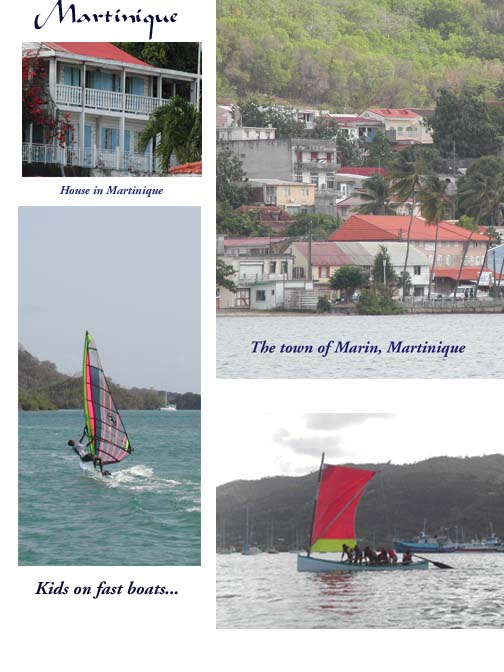
|
|
Log for the week of May 11, 2003 Iles de Saints, Guadeloupe by PS 1,734nm to Maine. Seems like it's just around the corner. Our stay in Martinique was marked by seeing boats towing their dinghies (last seen in the Great Barrier Reef), being surrounded by hundreds of sail boats (not seen on this trip till now) and sitting at anchor without movement (last seen when we were on the hard in Durban). The check in process in Martinique was the least hassle ever. Fill out one piece of paper (it even had English translations) show our passports to the Duane on the waterfront and we were in. No fees, no traveling around town to find the next official. Welcome to the French Caribbean! I did some minor repair work during our stay. The 50 gallon Nauta tank sprung a leak, so we took it out and put some tire patches over the holes. Seems OK now. I put a thin camping pad underneath to help with chafing. We also balanced the wind generator blades. I had brought a digital scale along, but it just wouldn't stabilize enough to be reliable. I rigged up a balance beam in the main cabin from a mop handle and found that two of the blades needed a South African one cent piece added to get them balanced. The mop handle method seemed a bit crude, so the next day we took them to shore and weighed them on a vegetable scale at the local store. Much to our surprise they were all exactly the same weight. Just goes to show you that simple things work well and our anchorage really was that calm. We rented a car for a day and toured the island. As this is the dry time of year, the scenery was quite parched. We did our usual taste test at the MacDonalds in Fort de France and found the burgers had star shaped buns and the expected taste. The only thing missing, for a MacDonalds on a French Island, were the topless girls sitting on the beach (last seen in Tahiti). Oh well. The most picturesque town was Saint-Pierre, where the entire city and 30,000 people were wiped out by the eruption of Mont Pele'e in May 8,1902. It was rebuilt shortly there after and these 100 year old houses dominate the present day town. The hills on the eastern side of the Island are covered with banana plantations scattered amongst various sea side resorts. After circumnavigating the island, we headed back up to Fort de France to do a major shopping spree for foodstuffs at the Super U. This also killed some time while the rush hour traffic dissipated. That's right, rush hour traffic. A subtle reminder of what reality is like on land. On the drive back to Marin, we discovered a DVD rental store only a few blocks from the dinghy landing. Voila'. Now we're in Paradise. Calm anchorage, home made ice cream and DVD movies! My reverie was broken by "We really should get moving. Hurricane season is coming." Amy was the one with itchy feet now. She was right though. So we left Marin on Saturday and headed for Illes de Saints, 100 miles to the north. We were told by our French friend this was "The Place" to go in the French Caribbean. Traveling on the lee side of Martinique and Dominica involved sailing and motoring with no wind to 25 knots of wind, anywhere from east to north-east to north-west. We had a double reefed main and stay-sail to handle these conditions. The passes between the islands were another story. Close hauled, into a north-east wind of 20 knots, made for little sleep. At least the passes were only 20 miles wide, so they were crossed in about 4 hours. Not bad all in all. Coastal navigation and avoiding other small craft kept us on edge during our watches. We are now anchored near the town of Bourg de Saintes and are looking forward to a breakfast of pain au chocolate and some site seeing tomorrow. If the wind clocks more to the southeast, our next stop is Antigua, 75 miles to the north, to visit friends. If it doesn't, then it's straight to St John's US Virgin Islands, 230 miles to the northwest with much better sailing conditions. Iwalani was designed to sail the Trades, not beat her way to windward! That's all for this week. PS
|
|
Log for the week of May 25, 2003 St. Martin, Eastern Caribbean by PS Monday, May 19, we celebrated my birthday with our friends Nick and Martha on Antigua. After driving us to a scenic overlook and gobbling down Amy's home-made sushi, we headed to their house for steak and cake. I try not to keep track of my age, but the parties are fun. Nick and Martha run a kite boarding school. It's just catching on here and they get clients from all over the world. Amy and I saw the world competition while we were in Noumea, New Caledonia two years ago. Over there, they call it Fly Surfing. Tell that to a Mainer and he would think you were fishing for stripped bass on the beach. For those of you who haven't heard of kite surfing, it's a bit like a human floatplane. You try to stand up on an undersized surfboard while a large stunt kite tries to get you airborne. It can and it does. I like flying, but I prefer wings and an engine. For those of you who want to know more go to www.kiteantigua.com. On Wednesday, we made the 110 mile, 24hr hop from Antigua to St Martin, sailing, motor-sailing and motoring thanks to fickle conditions. Amy managed to get some sleep, but I struggled just to rest my body. Fatigue is the enemy. The crew on "Stewball" lost their steel boat on a reef in Brazil due to fatigue. Just goes to show that even steel is not impervious to mistakes. We anchored just inside a classic wooden ketch from Britain. About 100 feet long, she dominated the view of modern French catamarans. Old vs. new. SV Irene was a reminder of where those cats came from. Wood and canvas. Tar and hemp. While modern boats may go fast, they pass everything but the repair shop when one of their high tech pieces goes awry. Like Iwalani, SV Irene could make repairs without the need for special welding equipment or a machine shop. Modern boats stop going fast when a turnbuckle breaks, the roller furling jams or the flimsy mast goes over the side (there are several examples in the harbor). Irene was ship shape and Bristol fashion. Bright bulwarks and snappy French courtesy flag showed a proud and well loved vessel. Sadly, the French flag was one of the last things to portray these traits. Just after dark, we heard an explosion. We were watching a DVD at the time and I had mistaken the sound as part of the movie. Shortly after, several dinghies zoomed by. I went on deck to see what the traffic was all about. The sight was horrific. Just a few hundred feet away, the entire stern section of Irene was ablaze. In a panic, we hurried to get in the dinghy and head over to help. Then I decided against it. There were dozens of dinghies around Irene. My concern was someone may be injured or burned. If that was the case, there were plenty of boats to come to their aid. We stood in silence, watching. What could we do? At that point, Irene was several minutes beyond the hope of return and I knew it. If there was a harbor fireboat at the scene, she might have been saved. But passing time sealed her fate. Every minute that went by added more wood and diesel to the inferno. I have witnessed three boats burn, so I knew the result. A hull burned to the waterline, still floating if conditions were calm. The irony of being surrounded by water and burning. Thoughts flew through our minds. Where was the fire boat? Could I rally a ship in the harbor to come to her aid? Ships have fire hoses on board, used mostly to keep pirates from boarding. If I had a chain saw, could I convince the owner that his best option was to let me cut large holes at the waterline and sink her quickly (she was in 10 feet of water). Fifteen minutes later a small fireboat showed up with a portable pump. In the glow, we could see they were having trouble keeping it going. When it was working, they seemed to slow the progress of fate. Our hopes rose. The glow diminished. The pump began struggling again. The flames regained control. The pumps feeble efforts were misdirected. The aft third of the boat was fully involved. The only hope may have been to put the pump onboard, up forward, battle the fire directly from upwind, wetting down the interior and working aft. Our hearts were breaking. If only we had a large water pump. If only we could have gotten to the fire in the first two or three minutes. Fire is like being holed. What happens in the first minutes is critical. If you don't have adequate pumps to keep the water at bay till you find a way to stem the flow, you end up with water so deep you can't tell where it's coming in. The problem becomes exponential. Time is the enemy. A Dutch Coastal Patrol boat arrived and our hopes rose once again. With hundreds of gallons a minute attacking the flames, water fought fire. For a second time the glow decreased. But the fire had the upper hand. Hidden below, out of reach of boat thrown water and foam, the fire crept towards the bow. Amy retired below. She had seen enough. She knows fire all to well, as she lost all her worldly possessions years ago to it. Smoke began to billow from the forward hatch. And aft, the fire was showing the blue flame of super heated fuel. Hope had passed. Seeing the futility, the Patrol boat ceased their efforts and the fire had its way. Rope ends burned upwards like slow fuses. The mizzen mast tumbled over the side, its rigging burned away. The bulwarks began to glow, showing the outline of frames and planking. Despite thousands of gallons of water sprayed on the fire, she wasn't sinking. Once again a reminder that it takes a tremendous amount of water to ultimately sink a boat. The fire broke out of the forward deck and the jibs flashed to ashes. The French courtesy flag was oblivious to its fate. Red, white and blue cloth shown in death's light. I could feel the heat and hear the roar of the future. Sickly mesmerized, I watched the loss. The loss of history. I finally stopped before the main mast collapsed. I went below and prayed no-one was hurt. The following morning showed the tops of charred frames lapped by the waves, the bowsprit level with the water, the masts gone, the keel firmly settled, the remains sitting level on the sandy bottom. People slowly motored around what was left. A dark shadow in the water. How quickly the road of life can take a sharp turn. 
We searched the Internet to learn more of Irene. Here is what we found: "Built by F J Carver and Son in Bridgwater, 1907, Irene was the last of the West Country Trading Ketch's still under sail. She sailed for 50 years as part of the fleet of British Merchant vessels through two world wars and a Great Recession. For many years she belonged to the Bridgwater Brick and Tile Company plying the waters of the Bristol Channel between Bridgwater and Ireland, carrying cargoes of tiles and bricks. Later she was used for transporting coal and clay around the coast. She retired from her trading service in 1960 and then changed hands a few times before being converted to a house boat. In 1965 she was found in a derelict state in the Hamble river, by her present owner, Doctor Leslie Morrish. He bought her for £2,500.00 and began a restoration job that lasted nearly 20 years. His initial task was to motor-sail Irene around to Brentford on the Thames, Irene's home for the next 15 years. The trip was not without mishap; going under Hammersmith Bridge the bowsprit stuck in the last span of the bridge, pierced the pavement, shut the bridge in the rush hour and cut off the gas supply to half of south London. It was a dramatic start to a new life. When Irene reached Brentford, Leslie Morrish and his family lived on board, using her as a house boat and restoring her at the same time. Once she had been restored to her former glory she was used for many commercials, film and fashion shoots. Irene played the part of "The Flying Dutchman" in the epic film biography of the composer Richard Wagner. Four years ago Irene undertook the Atlantic and made the crossing to the Caribbean where she has been available for exclusive charter ever since." 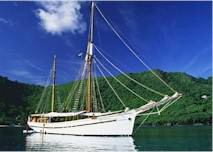
Amy bought a local paper but it was not clear how the fire started. No one seems to have been injured. The local fire boat was out for repairs, hence the long delay in bringing adequate resources to the scene. The paper did mention that there have been three fires in the last two months. Irene's demise triggered action on Iwalani. I checked the halon automatic system in the engine room. I hadn't done that since Australia. We also went over some fire scenarios. Two types come to mind.(1) A galley fire igniting flammable material. Pot holders and dish towels come to mind. There are no curtains on Iwalani"s port-lights. (2) Electrical fire. We came very close to this one with a loose battery switch cable connection. The only clue was the inability to charge one battery bank. The resistance of a bad connection caused heat, which melted the plastic to the point where the contacts no longer worked. This was no discount switch. It was rated for 600 continuous amps 1,000 peak amps. Why the connection decided to loosen up after two years, is anybody's guess. We always keep buckets handy on deck with a lanyard tied to them, a salt water wash-down hose and salt water spray hoses at the galley and head sinks give us a directional and unlimited water supply. There is a large CO2 extinguisher near the engine room door, a small halon extinguisher at the electrical panel in the nav station and an automatic halon system in the engine room. We also have a smoke detector in the engine room. The first action is direct attack of the fire. Shutting off the air supply, in the case of an engine room fire, is next. It would be safe to say that if we didn't have a fire out in 3 minutes, we would not be able to stop it. Three minutes is a long time. Smoke would be our biggest problem. People are over come by smoke long before the fire itself. Our life raft is on the fore deck for good reason. It's the last place likely to be affected by fire. So, where do we go from here? We plan to sail directly to Georgetown, but that would mean crossing Amy's least favorite part of the North Atlantic- George's Bank. There are too many seaman's ghosts there for her liking. So, our exact course has yet to be determined. We are checking in with Herb Hilgenberg on the SSB 12359 at 2000 UTC and will await his OK to cover our remaining 1,629 miles. PS |
